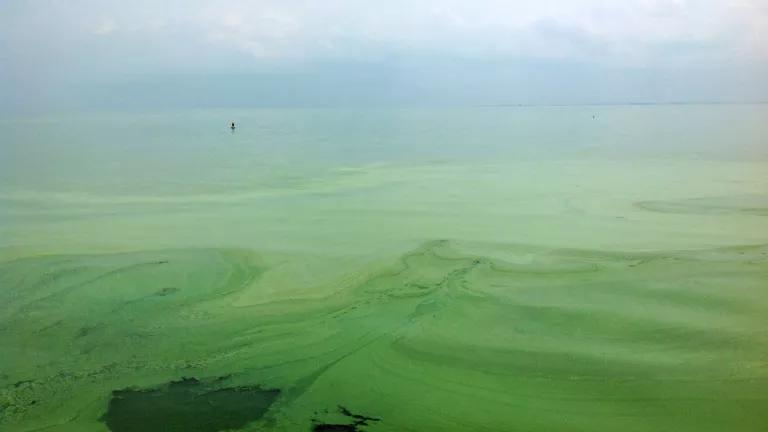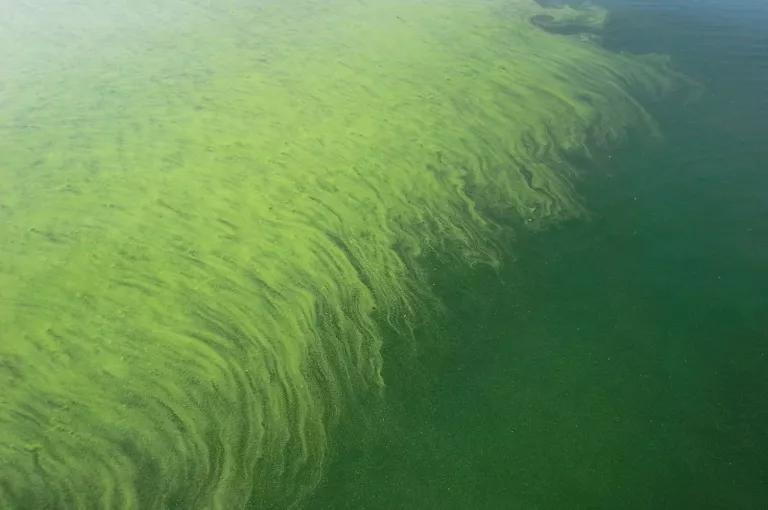Why Are Our Waters Turning Green?
Toxic algal blooms are suffocating waterways from the Gulf of Mexico to Lake Erie. The EPA needs to take on the polluters responsible for this slime.

Algal bloom on Western Lake Erie
In 2005, Hurricane Katrina slammed into the Louisiana coast and soon proved itself to be the costliest and deadliest storm in U.S. history. Five years later, the still-devastated region returned to the spotlight after a BP drilling rig exploded and spewed millions of gallons of oil into the Gulf of Mexico. But for decades before those disasters wreaked sudden havoc, another environmental issue had been quietly plaguing the Gulf's coastal waters: a massive "dead zone." It's as scary as it sounds; oxygen levels there are so low that the water can't support life.
In 2015, the Gulf of Mexico dead zone, which develops annually, was larger than the states of Connecticut and Rhode Island combined—and it's not getting any smaller. And unfortunately, the green, slimy algae that caused this dead zone isn't an anomaly. "The Gulf dead zone is the poster child," says Ann Alexander, legal advocacy director for NRDC's Midwest program, "but the problem is really nationwide."
Algae growth is spurred by two main sources of pollution: fertilizer runoff from farms and discharge from sewage treatment plants. Both add nitrogen and phosphorus to waterways, two nutrients that are essential to algae growth.
And algae outbreaks don't just cause dead zones; they can also poison our drinking water. Just ask the residents of Toledo, Ohio: A toxic algal bloom in Lake Erie shut down the city's water supply for three entire days in August 2014.
Despite these very real health and environmental risks, however, most states lack clear quantitative standards for just how much nitrogen or phosphorus can be discharged into the water. "Their regulations basically just say, 'Don't do anything that will cause too much algae growth,' " Alexander says. "I often compare it to the difference between a sign that says, 'Speed limit: 55 miles per hour' and a sign that says, 'Speed limit: Don't drive too fast.' No one knows quite what it means, and it's very hard to enforce."
The U.S. Environmental Protection Agency actually has the power to regulate nutrients, just as it regulates pollutants like mercury and ammonia. The Clean Water Act contains a provision that allows the federal government to step in if states aren't taking enough action to protect their waterways. Historically, it has chosen not to—but in 2008, NRDC petitioned the EPA to do just that.
When the agency didn't respond to the petition, NRDC threatened to sue. Feeling the pressure, the EPA skirted the issue, saying it would continue to encourage states to voluntarily monitor nutrient pollution—a strategy that clearly had been failing for decades.
Finally, in September 2013, a district court found this response inadequate; an appeals court upheld that decision in April 2015, sending the case back to district court. Here, NRDC continues to fight for the EPA to take responsibility for enforcing Clean Water Act protections.
While that federal fight plays out in court, NRDC is also working with environmental organizations up and down the Mississippi River. Their goal: to push states to create quantifiable standards for nitrogen and phosphorus, and to publicize the problems that can happen without these standards. People close to the Louisiana coast surely know about the Gulf dead zone, but the same might not be true for farmers upstream in other states.
Which brings us back to Toledo. If anything positive came out of Lake Erie's green algae nightmare, it's that the story made national news. If nothing else, it made people aware of the magnitude of the problem—which, according to Alexander, is "not yet part of the national consciousness."

The bigger the Gulf dead zone becomes, and the more frequently health crises like Toledo's occur elsewhere, the more likely the public will be to demand a solution. For now, affected cities are shouldering the burden of a problem they didn't create, paying large sums of money to ensure its residents are safe.
Take Des Moines, Iowa, for example: Thanks to the state's huge farming industry, its rivers contain unsafe levels of nitrogen, forcing the local water utility to filter out the chemicals at a cost of up to $10,000 a week. In March 2015, the city decided it had had enough and brought a lawsuit against three upstream agricultural counties responsible for the pollution.
Hopefully, this type of litigation—along with pressure on the EPA from NRDC and other environmental groups—will force both federal and local governments to finally step up to the plate and create enforceable regulations. Because in the end, it all comes down to numbers. As Alexander says, "If you can't measure the problem, you're not even to square one in terms of solving it."
This NRDC.org story is available for online republication by news media outlets or nonprofits under these conditions: The writer(s) must be credited with a byline; you must note prominently that the story was originally published by NRDC.org and link to the original; the story cannot be edited (beyond simple things such as grammar); you can’t resell the story in any form or grant republishing rights to other outlets; you can’t republish our material wholesale or automatically—you need to select stories individually; you can’t republish the photos or graphics on our site without specific permission; you should drop us a note to let us know when you’ve used one of our stories.


A Fearless Defender for Our Future
Freshwater Harmful Algal Blooms 101
California Hasn’t Come Clean About Its Water Use During the Drought